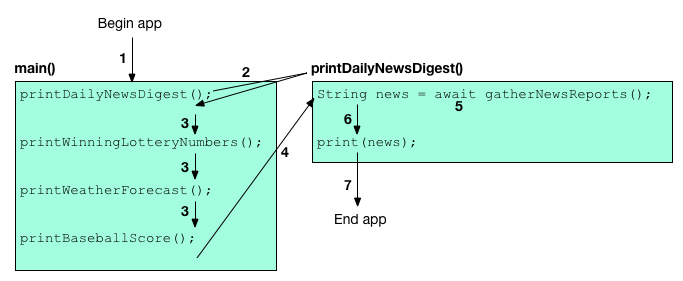Dart异步编程包含两部分:Future和Stream
该篇文章中介绍Future
异步编程:Futures
Dart是一个单线程编程语言。如果任何代码阻塞线程执行都会导致程序卡死。异步编程防止出现阻塞操作。Dart使用Future对象表示异步操作。
介绍
如下代码可能导致程序卡死
// Synchronous code printDailyNewsDigest() { String news = gatherNewsReports(); // Can take a while. print(news); } main() { printDailyNewsDigest(); printWinningLotteryNumbers(); printWeatherForecast(); printBaseballScore(); }
该程序获取每日新闻然并打印,然后打印其他一系列用户感兴趣的信息:
<gathered news goes here> Winning lotto numbers: [23, 63, 87, 26, 2] Tomorrow's forecast: 70F, sunny. Baseball score: Red Sox 10, Yankees 0
该代码存在问题printDailyNewsDigest读取新闻是阻塞的,之后的代码必须等待printDailyNewsDigest结束才能继续执行。当用户想知道自己是否中彩票,明天的天气和谁赢得比赛,都必须等待printDailyNewsDigest读取结束。
为了程序及时响应,Dart的作者使用异步编程模型处理可能耗时的函数。这个函数返回一个Future
什么是Future
Future表示在将来某时获取一个值的方式。当一个返回Future的函数被调用的时候,做了两件事情:
1. 函数把自己放入队列和返回一个未完成的Future对象
2. 之后当值可用时,Future带着值变成完成状态。
为了获得Future的值,有两种方式:
1. 使用async和await
2. 使用Future的接口
Async和await
async和await关键字是Dart异步支持的一部分。他们允许你像写同步代码一样写异步代码和不需要使用Future接口。
注:在Dart2中有轻微的改动。async函数执行时,不是立即挂起,而是要执行到函数内部的第一个await。在多数情况下,我们不会注意到这一改动
下面的代码使用Async和await读取新闻
// Copyright (c) 2013, the Dart project authors. Please see the AUTHORS file // for details. All rights reserved. Use of this source code is governed by a // BSD-style license that can be found in the LICENSE file. import 'dart:async'; printDailyNewsDigest() async { String news = await gatherNewsReports(); print(news); } main() { printDailyNewsDigest(); printWinningLotteryNumbers(); printWeatherForecast(); printBaseballScore(); } printWinningLotteryNumbers() { print('Winning lotto numbers: [23, 63, 87, 26, 2]'); } printWeatherForecast() { print("Tomorrow's forecast: 70F, sunny."); } printBaseballScore() { print('Baseball score: Red Sox 10, Yankees 0'); } const news = '<gathered news goes here>'; Duration oneSecond = const Duration(seconds: 1); final newsStream = new Stream.periodic(oneSecond, (_) => news); // Imagine that this function is more complex and slow. :) Future gatherNewsReports() => newsStream.first; // Alternatively, you can get news from a server using features // from either dart:io or dart:html. For example: // // import 'dart:html'; // // Future gatherNewsReportsFromServer() => HttpRequest.getString( // 'https://www.dartlang.org/f/dailyNewsDigest.txt', // );
执行结果:
Winning lotto numbers: [23, 63, 87, 26, 2] Tomorrow's forecast: 70F, sunny. Baseball score: Red Sox 10, Yankees 0 <gathered news goes here>
从执行结果我们可以注意到printDailyNewsDigest是第一个调用的,但是新闻是最后才打印,即使只要一行内容。这是因为代码读取和打印内容是异步执行的。
在这个例子中间,printDailyNewsDigest调用的gatherNewsReports不是阻塞的。gatherNewsReports把自己放入队列,不会暂停代码的执行。程序打印中奖号码,天气预报和比赛分数;当gatherNewsReports完成收集新闻过后打印。gatherNewsReports需要消耗一定时间的执行完成,而不会影响功能:用户在读取新闻之前获得其他消息。
下面的图展示代码的执行流程。每一个数字对应着相应的步骤

1. 开始程序执行
2. main函数调用printDailyNewsDigest,因为它被标记为async,所有在该函数任何代码被执行之前立即返回一个Future。
3. 剩下的打印执行。因为它们是同步的。所有只有当一个打印函数执行完成过后才能执行下一个打印函数。例如:中奖号码在天气预报执行打印。
4. 函数printDailyNewsDigest函数体开始执行
5. 在到达await之后,调用gatherNewsReports,程序暂停,等待gatherNewsReports返回的Future完成。
6. 当Future完成,printDailyNewsDigest继续执行,打印新闻。
7. 当printDailyNewsDigest执行完成过后,最开始的Future返回完成,程序退出。
注:如果async函数没有明确指定返回值,返回的null值的Future
错误处理
如果在Future返回函数发生错误,你可能想捕获错误。Async函数可以用try-catch捕获错误。
printDailyNewsDigest() async { try { String news = await gatherNewsReports(); print(news); } catch (e) { // Handle error... } }
try-catch在同步代码和异步代码的表现是一样的:如果在try块中间发生异常,那么在catch中的代码执行
连续执行
你可以使用多个await表达式,保证一个await执行完成过后再执行下一个
// Sequential processing using async and await. main() async { await expensiveA(); await expensiveB(); doSomethingWith(await expensiveC()); }
expensiveB函数将等待expensiveA完成之后再执行。
Future API
在Dart1.9之前还没有添加async和await时,你必须使用Future接口。你可能在一些老的代码中间看到使用Future接口
为了使用Future接口写异步代码,你需要使用then()方法注册一个回调。当Future完成时这个回调被调用。
下面的代码使用Future接口:
// Copyright (c) 2013, the Dart project authors. Please see the AUTHORS file // for details. All rights reserved. Use of this source code is governed by a // BSD-style license that can be found in the LICENSE file. import 'dart:async'; printDailyNewsDigest() { final future = gatherNewsReports(); future.then((news) => print(news)); } main() { printDailyNewsDigest(); printWinningLotteryNumbers(); printWeatherForecast(); printBaseballScore(); } printWinningLotteryNumbers() { print('Winning lotto numbers: [23, 63, 87, 26, 2]'); } printWeatherForecast() { print("Tomorrow's forecast: 70F, sunny."); } printBaseballScore() { print('Baseball score: Red Sox 10, Yankees 0'); } const news = '<gathered news goes here>'; Duration oneSecond = const Duration(seconds: 1); final newsStream = new Stream.periodic(oneSecond, (_) => news); // Imagine that this function is more complex and slow. :) Future gatherNewsReports() => newsStream.first; // Alternatively, you can get news from a server using features // from either dart:io or dart:html. For example: // // import 'dart:html'; // // Future gatherNewsReportsFromServer() => HttpRequest.getString( // 'https://www.dartlang.org/f/dailyNewsDigest.txt', // );
注意到printDailyNewsDigest被首先调用,但是新闻在最后被打印。这是因为代码读取内容是异步执行的。
程序执行流程:
1. 程序开始执行
2. main函数调用printDailyNewsDigest函数,在函数内部调用gatherNewsReports
3. gatherNewsReports收集新闻然后返回一个Future
4. printDailyNewsDigest使用then指定Future的响应函数。调用then()返回的新Future将使用then指定回调返回的值完成。
5. 剩下的打印函数同步执行,因为他们是同步的
6. 当所有新闻到达,gatherNewsReports返回的Future带着一个包含新闻的字符串完成
7. 在printDailyNewsDigest中then函数指定的回调函数执行。打印新闻
8. 程序退出
在printDailyNewsDigest函数中then可以多种不同的方式写。
1. 使用花括号。当有多个操作的时候,这种方式比较方便
printDailyNewsDigest() { final future = gatherNewsReports(); future.then((news) { print(news); // Do something else... }); }
2. 直接传print函数
printDailyNewsDigest() =>
gatherNewsReports().then(print);
错误处理
使用Future接口,你可以使用catchError捕获错误
printDailyNewsDigest() => gatherNewsReports() .then((news) => print(news)) .catchError((e) => handleError(e));
如果新闻不可用,那么代码的执行流程如下:
1. gatherNewsReports的Future带一个Error完成。
2. then的Future带一个Error完成。
3. catchError的回调处理错误,catchError的Future正常结束,错误不在被传递。
当使用Future接口时,在then后连接catchError,可以认为这一对接口相应于try-catch。
像then(), catchError返回一个带回调返回值的新Future
使用then连接多个函数
当Future返回时需要顺序执行多个函数是,可以串联then调用
expensiveA() .then((aValue) => expensiveB()) .then((bValue) => expensiveC()) .then((cValue) => doSomethingWith(cValue));
使用Future.wait等待多个Future完成
当wait的所有Future完成时,Future.wait返回一个新的Future。这个Future带了一个包含所有等待结果的列表。
Future .wait([expensiveA(), expensiveB(), expensiveC()]) .then((List responses) => chooseBestResponse(responses)) .catchError((e) => handleError(e));
当任意一个调用以error结束时,那么Future.wait也以一个Error结束。使用catchError处理错误
参考: https://www.dartlang.org/tutorials/language/futures